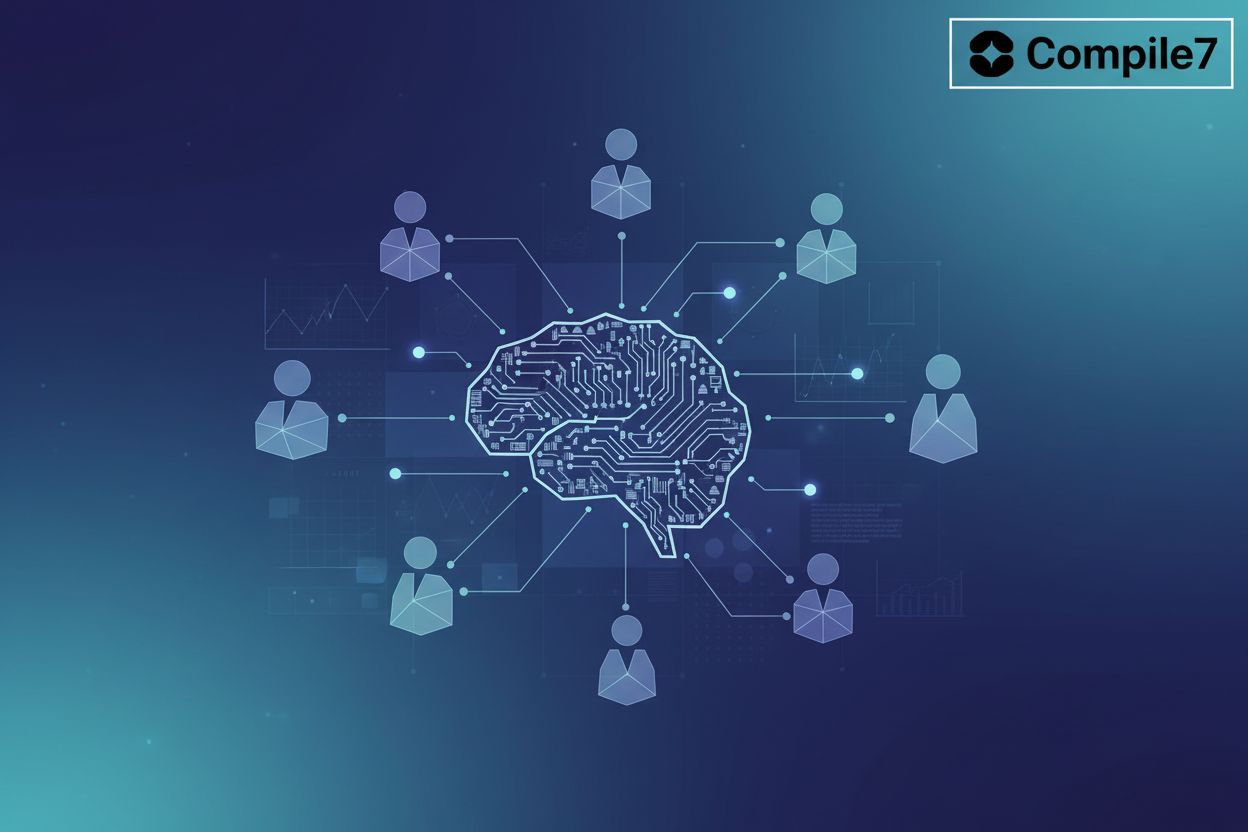Quantum Machine Learning: Revolutionizing AI for Business Automation
Introduction to Quantum Machine Learning
Quantum Machine Learning (QML) is no longer a futuristic fantasy; it's rapidly becoming a tangible tool for business automation. Imagine a world where complex problems like optimizing global supply chains in real-time or discovering new drug compounds are solved in minutes instead of months.
Quantum Machine Learning merges the principles of quantum computing with machine learning algorithms. It uses qubits and quantum operations to tackle complex machine learning tasks more efficiently than classical computers. Jay Pandit describes it as "teaching a mind that can daydream every possible answer at once."
QML harnesses quantum phenomena such as:
- Superposition: Allows qubits to represent multiple states simultaneously.
- Entanglement: Creates correlations between qubits, enhancing computational power.
- Interference: Guides computation towards the correct answer by manipulating probabilities. This is achieved by using constructive interference to amplify the probability of correct outcomes and destructive interference to cancel out incorrect ones.
QML aims to improve both space and time complexity compared to traditional machine learning PennyLane. This parallel processing capability, as highlighted by Jay Pandit, gives quantum computers an edge in specific tasks.
Classical ML relies heavily on linear algebra and GPUs to simulate parallelism. In contrast, Quantum ML encodes data into quantum states, exploring a vast Hilbert space in parallel.
Here is a simple comparison:
- Classical ML: Processes data sequentially using bits.
- Quantum ML: Utilizes qubits, leveraging superposition and entanglement for parallel computation.
Quantum circuits are designed to guide computations toward the most probable solution, offering a unique approach to problem-solving. Hybrid approaches, combining both quantum and classical resources, are also gaining traction.

The transformative potential of Quantum ML spans across various industries. Imagine:
- Faster drug discovery: Accelerating the identification of new drug candidates.
- Smarter robots: Developing ai that learns from fewer examples, increasing efficiency.
- Enhanced security: Securing communications with unbreakable cryptography.
QML enables optimization of complex processes that are currently beyond the reach of classical methods. Early adoption of this disruptive technology could provide a significant competitive advantage.
As we delve deeper, the next section will explore the specific quantum algorithms driving this revolution.
Quantum Machine Learning Algorithms and Techniques
Quantum Machine Learning algorithms offer innovative solutions for complex problems, but how do they actually work? Let's explore some of the core techniques driving this cutting-edge field.
Quantum associative memories store patterns within unitary matrices. Retrieval of information relies on unitary evolution, guiding the system toward a superposition of desired patterns. This method boasts superior capacity compared to classical associative memories, largely because it eliminates cross-talk. Quantum associative memories are efficient for managing any polynomial number of patterns.
Amplitude encoding plays a crucial role by associating quantum state amplitudes with computation inputs and outputs. This allows for an exponentially compact representation of data. Amplitude encoding is a crucial step in preparing the quantum state for algorithms like HHL, which then leverage this compact representation for potential speedups. Based on variations of the quantum algorithm for linear systems of equations (HHL), this technique offers the potential for logarithmic time complexity in input dimension.
Variational Quantum Algorithms (VQAs) offer a hybrid approach, using both classical and quantum resources.
- A classical computer optimizes parameters for quantum state preparation.
- The quantum computer handles state preparation and measurement.
VQAs are particularly promising for noisy intermediate-scale quantum (NISQ) computers. They are used to solve optimization problems and find ground state energies.

As we continue to refine these algorithms, the potential for real-world applications grows. Next, we'll explore quantum machine learning applications for business automation.
Applications of Quantum Machine Learning in Business
Harnessing the power of quantum mechanics, Quantum Machine Learning opens new doors for businesses seeking advanced automation capabilities. The ability to process vast amounts of data and identify complex patterns makes Quantum Machine Learning a transformative tool across diverse sectors.
QML algorithms excel at analyzing large datasets to uncover hidden patterns and insights. This capability enhances:
- Anomaly detection in financial transactions: QML can identify fraudulent activities with greater precision than classical systems by analyzing intricate, multi-dimensional correlations that are computationally prohibitive for classical algorithms.
- Image and speech recognition for customer service ai: Quantum algorithms improve the accuracy of ai-driven customer interactions, leading to more effective support.
- Predictive modeling based on complex datasets: QML enhances forecasting in areas like market trends and customer behavior.
One of the key strengths of QML lies in its ability to optimize complex processes. This leads to improvements in:
- Supply chain logistics and resource allocation: QML can optimize routes, inventory levels, and delivery schedules, reducing costs and improving efficiency.
- Scheduling and routing algorithms for transportation: Quantum algorithms optimize routes for delivery fleets, reducing fuel consumption and transit times.
- Personalized marketing campaigns through better customer segmentation: QML enables more targeted marketing strategies.
The healthcare and materials industries are poised to benefit significantly from QML. Quantum simulations can drive:
- Identification of drug candidates through molecular simulations: QML accelerates the discovery process for new pharmaceuticals.
- Design of novel materials with specific properties: Quantum simulations enable the creation of materials with enhanced characteristics.
- Optimization of chemical processes for increased efficiency: QML reduces waste and boosts productivity in chemical manufacturing.
As Quantum Machine Learning continues to mature, even more innovative applications will emerge. Next, we'll explore the challenges and opportunities associated with implementing Quantum Machine Learning in business.
Challenges and Limitations of Quantum Machine Learning
Quantum Machine Learning holds immense promise, but it's not without its hurdles. Let's explore the limitations and challenges that businesses face when venturing into this cutting-edge field.
The current state of quantum computing hardware presents significant constraints.
- Noisy qubits: Today's quantum computers operate with significant noise. This noise leads to errors in computations, limiting the complexity of algorithms we can run.
- Limited qubit counts: Existing quantum computers have a relatively small number of qubits. This restricts the size and scope of problems that QML can tackle effectively. These limitations, including noisy qubits and limited qubit counts, characterize the current NISQ (Noisy Intermediate-Scale Quantum) era, as noted by Jay Pandit.
- Decoherence: Qubits are extremely sensitive to their environment. This sensitivity leads to decoherence, where qubits lose their quantum properties.
These hardware limitations affect the types of QML algorithms that can be implemented.
Beyond hardware, the algorithms themselves pose challenges.
- Outperforming classical algorithms: Designing quantum algorithms that demonstrate a clear advantage over classical methods is difficult. For many machine learning tasks, classical algorithms remain more efficient.
- Data encoding bottlenecks: Efficiently encoding classical data into quantum states is a significant hurdle. Amplitude encoding can be compact, but is also hard to implement due to the difficulty of preparing quantum states with specific amplitudes efficiently, as noted by Jay Pandit.
- Scalability issues: Scaling quantum algorithms to handle the large datasets often required for real-world business applications is a major challenge.
A significant barrier to QML adoption is the shortage of skilled professionals.
- Need for interdisciplinary expertise: QML requires expertise in both machine learning and quantum computing. This combination of skills is rare, creating a talent bottleneck.
- Training and education: Filling the skills gap requires substantial investment in training and education programs. Businesses must invest in upskilling their existing workforce or attracting talent from academia.
- Talent acquisition: The limited pool of QML experts means that companies must compete fiercely to attract and retain talent.
Despite these challenges, the potential rewards of QML are driving ongoing research and development. As we address these hurdles, QML will become more accessible and practical for business automation.
In the next section, we will delve into the opportunities that QML presents for business, despite its current limitations.
The Future of Quantum Machine Learning and AI
Quantum Machine Learning is not just about future possibilities; it's also influencing current algorithms. Let's explore the advancements that are shaping the future of Quantum Machine Learning (QML) and its impact on ai.
Error correction is crucial for QML's practical application. Current quantum computers are prone to errors due to decoherence and noise. Error correction methods mitigate these issues, paving the way for more reliable and complex computations.
Achieving fault-tolerance is crucial for running complex algorithms like Quantum Support Vector Machines (QSVM). Estimates suggest that approximately 1,000 logical qubits will be needed for QSVM to effectively process image data. This benchmark highlights the scale of quantum resources needed for real-world applications.
Fault-tolerance will enable deeper and more complex quantum algorithms. As quantum computers become more stable, they can execute longer and more intricate algorithms. This capability expands the range of problems QML can address.
Tensor network classifiers running on classical hardware can emulate some quantum advantages. This approach allows researchers to explore quantum-like benefits without the need for actual quantum computers, by efficiently representing and manipulating high-dimensional quantum states on classical computers. It can offer speed and efficiency gains in specific machine learning tasks.
Classical machine learning benefits from these quantum-inspired techniques. The insights gained from quantum computing research translate into improvements in classical algorithms. By adapting quantum concepts, developers can enhance the performance of existing classical systems.
Bridging the gap between quantum and classical computing through algorithm design is crucial. Quantum-inspired methods provide a pathway for integrating quantum insights into conventional computing.
The need for understandable models emerges in quantum machine learning, mirroring the challenges in classical machine learning. As QML models become more complex, the ability to interpret their decisions becomes essential. This helps in building trust and ensuring accountability.
Efforts are often referred to as Interpretable Machine Learning (IML) or IQML, extending classical interpretability concepts to quantum systems. This field aims to make quantum models transparent and understandable.
XQML/IQML can be seen as an alternative research direction instead of solely focusing on achieving quantum advantage. By prioritizing interpretability, researchers can create QML models that are more practical and trustworthy.
Quantum Shapley values have been proposed to interpret gates within a circuit based on a game-theoretic approach. This method helps identify the contribution of individual components to the overall outcome.
As research progresses, these advancements will further enhance the capabilities and applicability of QML in business automation. Next, we will look at the skills and resources businesses need to embrace quantum machine learning.
Getting Started with Quantum Machine Learning
Embarking on the Quantum Machine Learning journey may seem daunting, but with the right strategy, it can be manageable. Let's explore how to get started.
Compile7 specializes in developing custom ai agents that automate tasks, enhance productivity, and transform how your business operates. These agents can streamline various aspects of QML implementation.
Explore Compile7's Customer Service Agents to streamline quantum information dissemination and support. These agents can handle queries about QML technologies, provide documentation, and offer troubleshooting assistance.
Utilize Data Analysis Agents for preprocessing quantum simulation data and identifying relevant patterns. These agents can automate the extraction of key features from quantum simulation outputs, such as identifying optimal parameters or analyzing error rates, saving valuable time and resources.
Empower your team with Content Creation Agents to develop educational materials on quantum computing and QML. These agents can generate articles, tutorials, and presentations, helping to build expertise within your organization.
Compile7's Industry-Specific Agents can accelerate the integration of QML solutions in your sector.
Familiarize yourself with quantum software frameworks. IBM Qiskit and PennyLane are popular choices, offering tools for building and simulating quantum circuits. Frameworks like Qiskit and PennyLane often provide higher-level abstractions and tools, while languages like Q# offer the fundamental syntax for programming quantum computers. PennyLane is particularly designed for machine learning applications.
Consider accessing quantum hardware through cloud-based platforms. This allows you to run experiments on real quantum computers without the need for expensive infrastructure.
Use simulation tools for prototyping and testing quantum algorithms. Simulators allow you to experiment with different algorithms and parameters before deploying them on actual quantum hardware.
Learning quantum programming languages such as Q# is essential for developing custom QML applications.
Hire data scientists with quantum computing expertise. As noted earlier, the combination of skills is rare, creating a talent bottleneck.
Collaborate with quantum computing research institutions. Partnering with universities or research labs can provide access to cutting-edge knowledge and resources.
Invest in training and development programs for employees. Upskilling your existing workforce can help bridge the skills gap and build internal expertise.
Foster a culture of innovation and experimentation. Encourage your team to explore new ideas and approaches to QML, creating an environment of continuous learning.
With a strategic approach, businesses can effectively start their journey into Quantum Machine Learning, paving the way for future innovation. Next, we will highlight the skills and resources businesses need to embrace quantum machine learning.
Conclusion: Embracing the Quantum AI Revolution
Quantum Machine Learning may sound like a distant dream, but its potential impact on business automation is very real. While it isn't a magic bullet, it's a powerful tool.
QML shines when the quantum structure aligns with the data structure. This alignment is crucial because quantum computers can naturally represent and manipulate the complex, multi-dimensional relationships inherent in quantum systems, such as the electronic configurations of molecules. Think of applications like drug discovery or materials science, where molecules and materials have inherent quantum properties.
Focus on hybrid prototypes on Noisy Intermediate-Scale Quantum (NISQ) chips in the near term. These hybrid approaches combine the strengths of both classical and quantum computing.
Learning QML now positions businesses for future hardware breakthroughs. As quantum computers improve, early adopters will be ready to leverage their full potential.
Quantum computing will eventually revolutionize ai and business automation. We can expect to see quantum-enhanced algorithms optimizing complex processes across various industries.
Early adoption of QML provides a competitive edge. Businesses that invest in QML research and development today will be well-positioned to lead in the future.
Quantum ai agents will transform industries and create new opportunities. Imagine ai agents that can solve problems currently beyond our reach, unlocking new levels of efficiency and innovation.
Embracing QML now, even in its early stages, is crucial for future-proofing your business and driving innovation. As quantum hardware continues to advance towards achieving quantum advantage, the possibilities for business automation will become increasingly profound.





